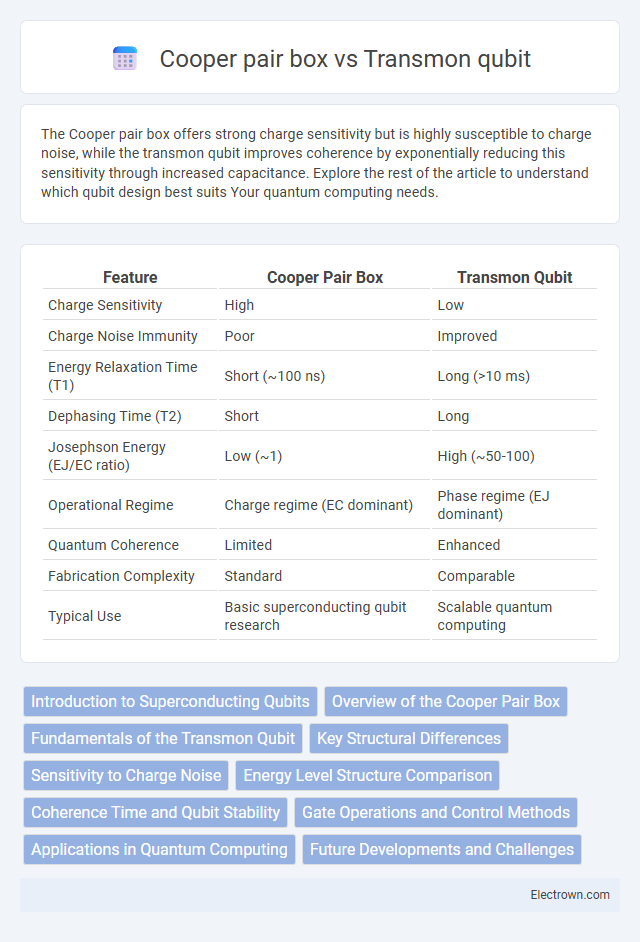The Cooper pair box offers strong charge sensitivity but is highly susceptible to charge noise, while the transmon qubit improves coherence by exponentially reducing this sensitivity through increased capacitance. Explore the rest of the article to understand which qubit design best suits Your quantum computing needs.
Table of Comparison
| Feature | Cooper Pair Box | Transmon Qubit |
|---|---|---|
| Charge Sensitivity | High | Low |
| Charge Noise Immunity | Poor | Improved |
| Energy Relaxation Time (T1) | Short (~100 ns) | Long (>10 ms) |
| Dephasing Time (T2) | Short | Long |
| Josephson Energy (EJ/EC ratio) | Low (~1) | High (~50-100) |
| Operational Regime | Charge regime (EC dominant) | Phase regime (EJ dominant) |
| Quantum Coherence | Limited | Enhanced |
| Fabrication Complexity | Standard | Comparable |
| Typical Use | Basic superconducting qubit research | Scalable quantum computing |
Introduction to Superconducting Qubits
Superconducting qubits are essential components in quantum computing, leveraging superconducting circuits to create coherent quantum states. Cooper pair boxes are charge-based qubits highly sensitive to charge noise, maintaining qubit states through controlled Cooper pair tunneling. Transmon qubits enhance coherence by increasing Josephson energy relative to charging energy, reducing charge noise sensitivity and improving qubit stability and scalability in quantum processors.
Overview of the Cooper Pair Box
The Cooper pair box is a superconducting qubit based on a small superconducting island connected to a reservoir via a Josephson junction, allowing control through the charge degree of freedom. This device operates by manipulating discrete charge states, but it is highly sensitive to charge noise, leading to decoherence that limits qubit performance. Your understanding of the Cooper pair box provides a foundation for exploring the transmon qubit, which enhances coherence by reducing charge noise sensitivity through increased Josephson energy.
Fundamentals of the Transmon Qubit
The transmon qubit is an evolution of the Cooper pair box that significantly reduces charge noise sensitivity by increasing the ratio of Josephson energy to charging energy (E_J/E_C). Its design incorporates a large shunt capacitor, which stabilizes the island's charge and enhances coherence times, making it a preferred choice for scalable quantum computing. Understanding the fundamentals of the transmon qubit helps you optimize qubit performance in superconducting quantum circuits.
Key Structural Differences
The Cooper pair box consists of a small superconducting island connected to a reservoir via a Josephson junction, with its charge states controlled by a gate voltage, making it highly sensitive to charge noise. The transmon qubit is a modified Cooper pair box with a larger shunt capacitor that reduces charge dispersion by increasing the ratio of Josephson energy to charging energy, enhancing coherence times. This structural adjustment in the transmon qubit results in improved noise resilience while maintaining sufficient anharmonicity for qubit operations.
Sensitivity to Charge Noise
The Cooper pair box qubit exhibits high sensitivity to charge noise due to its dependence on discrete charge states, leading to rapid decoherence and reduced qubit coherence times. In contrast, the transmon qubit significantly suppresses charge noise sensitivity by increasing the ratio of Josephson energy to charging energy (E_J/E_C), resulting in enhanced charge noise insensitivity and improved coherence properties. Your quantum computing applications will benefit from transmon qubits' robustness against charge fluctuations, making them more suitable for scalable and reliable superconducting qubit architectures.
Energy Level Structure Comparison
The Cooper pair box exhibits a strongly anharmonic energy level structure due to its small Josephson energy to charging energy ratio (E_J/E_C), which allows distinct, well-separated qubit states ideal for quantum computation. In contrast, the transmon qubit features a larger E_J/E_C ratio, significantly reducing charge noise sensitivity while slightly decreasing anharmonicity, resulting in energy levels that are more evenly spaced but still sufficiently discernible for qubit operations. This balance in the transmon enhances coherence times and gate fidelity, making it preferable for scalable quantum processors despite a less pronounced energy level separation compared to the Cooper pair box.
Coherence Time and Qubit Stability
The transmon qubit offers significantly improved coherence time compared to the Cooper pair box by reducing sensitivity to charge noise through its large Josephson energy to charging energy ratio. This enhancement in qubit stability allows your quantum circuits to maintain superposition states longer, making transmons favorable for scalable quantum computing. Cooper pair boxes, although more sensitive to charge fluctuations, provide insights into charge qubit behavior but generally exhibit shorter coherence times and less stable qubit operations.
Gate Operations and Control Methods
Cooper pair boxes rely on charge states for gate operations, utilizing voltage pulses for precise control, which makes them highly sensitive to charge noise and requires careful isolation techniques. Transmon qubits enhance control by operating in a regime with reduced charge dispersion, employing microwave-driven pulses for gate operations that offer improved coherence and robustness against charge fluctuations. Your choice between these qubit types influences the complexity of gate calibration and the fidelity of quantum operations in superconducting quantum circuits.
Applications in Quantum Computing
Cooper pair boxes offer precise charge sensitivity making them suitable for fundamental quantum experiments and quantum metrology, though they suffer from charge noise limiting coherence times. Transmon qubits, engineered with large shunting capacitors to suppress charge noise, enable longer coherence times, making them the preferred choice for scalable quantum computing architectures and quantum error correction protocols. Their enhanced coherence and robust control have propelled transmons to the forefront of superconducting qubit implementations in practical quantum processors.
Future Developments and Challenges
Future developments in Cooper pair box and transmon qubit technologies emphasize enhancing coherence times and reducing noise sensitivity, crucial for scaling quantum processors. Transmon qubits offer improved robustness against charge noise compared to Cooper pair boxes, yet challenges persist in material imperfections and qubit connectivity. Your ability to optimize qubit designs and integrate error correction protocols will be vital in overcoming these hurdles and advancing quantum computing performance.
Cooper pair box vs transmon qubit Infographic

 electrown.com
electrown.com